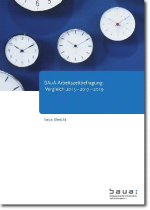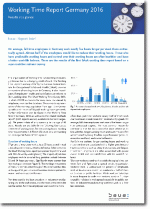Figures, data and facts on the organisation of working time
The organization of working time is a key issue in occupational safety and health. It also determines the amount of time available for recreation and personal matters. Given the changing demands in the world of work, the regulation and organization of working time are central topics in political, economic, and public debates in Germany. Through the BAuA Working Time Survey, the Federal Institute for Occupational Safety and Health (BAuA) provides an empirical database for this discussion.
As part of the BAuA Working Time Survey, employed individuals have been interviewed about their working hours every two years since 2015. The current survey, conducted in 2023, was again carried out with more than 11,000 employed individuals and provides up-to-date data on working time arrangements in Germany. The data offers a detailed insight into the working time reality of employees and allows for an assessment of issues related to working time and its organization. The following presents findings based on the latest data from the BAuA Working Time Survey 2023.
Working Time Duration, Overtime and Short Rest Periods
The average actual weekly working hours of German employees decreased slightly from 38.8 hours in 2019 to 38.5 hours in 2023. This decline is primarily due to a reduction in working hours among men (2019: 42.3 hours, 2023: 41.4 hours). In contrast, there was a slight increase for women (2019: 34.9 hours, 2023: 35.0 hours). In 2023, employees worked an average of 3.1 overtime hours per week, representing a slight decrease compared to 2019 (3.4 hours). This decline is exclusively seen among men (2019: 3.8 hours, 2023: 3.4 hours), while the overtime hours for women in 2023 remained at the same level as in 2019, with 2.9 hours.
In addition to the duration of working hours, adequate rest periods are also crucial for recovery and the restoration of work ability. Typically, there must be at least eleven hours of uninterrupted rest between the end of one workday and the beginning of the next.
Since 2017, the proportion of employees who experience a short rest period of less than eleven hours at least once a month has remained consistently between 16 and 18 percent. Part-time employees are, as in previous years, less affected by shortened rest periods in 2023, with 9 percent compared to employees with moderate or long full-time employment (35–48 hours: 15 percent). Among those with excessively long full-time work (more than 48 hours), around 51 percent of employees experience reduced rest periods.
Atypical Working Time Arrangements: Working When Others Have Time Off
The organization of working time also includes work on weekends and holidays-periods that are particularly important for social contacts, leisure activities, and rest. Current data from the BAuA Working Time Survey 2023 show a slight decline in weekend work. While 40 percent of employees worked at least once a month on weekends in 2019, this share decreased to 36 percent in 2023. This trend is observed for both men and women: in 2019, 42 percent of men and 38 percent of women reported regular weekend work, while in 2023, it was 36 percent in both groups
In addition to weekend work, work outside of the 7 a.m. to 7 p.m. time frame has also slightly decreased in recent years. 19 percent of employees regularly worked during these off-hours - a decrease from 21 percent in 2019. While the share remained largely stable for men (2019: 21%, 2023: 22%), there was a significant decline among women. In 2019, 21 percent of women worked outside core hours, but by 2023, this had dropped to only 16 percent.
Advantages and Disadvantages of Flexible Working Time
The flexibilization of working hours has increased in recent years and can bring benefits to both employers and employees. However, different perspectives need to be considered. Employer-oriented flexibility, such as overtime, shift work, or on-call work, allows businesses to respond to economic fluctuations. For employees, however, this often means less predictability of working hours, which can negatively affect health and work-life balance.
In contrast, employee-oriented flexibility - such as flextime or individual working time arrangements - provides more control over one's own working hours. This makes it easier to reconcile work and personal life and is often associated with better health and higher satisfaction.
The results of the BAuA Working Time Survey 2023 confirm the ongoing trend toward more flexibility options for employees. More and more workers are able to tailor their working hours to their individual needs:
- Start and finish times: 49 percent were able to determine when they start or finish work (2021: 46 percent).
- Breaks: 65 percent of employees reported having (a lot of) influence on their break times (2019: 58 percent).
- Taking some hours off: 54 percent were able to take time off flexibly (2021: 52 percent).
- Taking vacation and free days: 67 percent had control over when they took vacation or free days (2021: 66 percent).
Working Time Recording: Noticeable Increase, Especially in Remote Work
Working time recording plays a central role in occupational health and safety. It not only enables transparent recording of overtime and fair compensation but also ensures that working time regulations are adhered to. Judgments from the European Court of Justice (2019) and the Federal Labor Court (2022) require employers to systematically record daily working hours. Comprehensive documentation supports health-oriented working time arrangements, facilitates risk assessments, and contributes to preventive workplace design. Additionally, it is an important tool for government workplace safety oversight.
Working time recording is widespread: around 80 percent of employees document their working hours. Compared to 2021, there has been a slight increase in the use of working time recording through a time account in 2023 – the share rose from 66 to 69 percent.
This increase is particularly evident among employees with high job demands: in highly complex roles, the use of a time account increased from 64 to 73 percent. The growth is especially strong in company-related service professions as well as IT and scientific service professions, where previously above-average numbers of employees did not record their working hours.
Since these professional groups more often have telework or home office agreements, it is not surprising that working time recording in home offices has also significantly increased. In 2019, the share of unrecorded working hours was 35 percent, in 2021 it was 27 percent, and in 2023 it was 20 percent. Especially when working from home (e.g., in the context of telework, home office, or mobile work), there is often a risk that working hours may be extended or the boundaries between working time and leisure time become blurred.
























